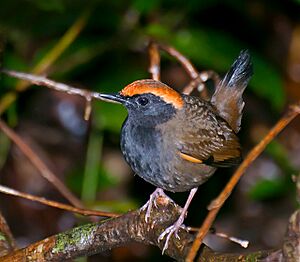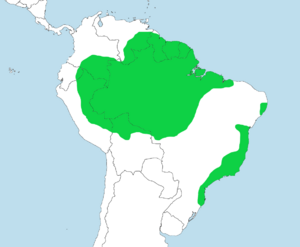Rufous-capped antthrush facts for kids
Quick facts for kids Rufous-capped antthrush |
|
|---|---|
 |
|
| In Vale do Ribeira, Registro, São Paulo, Brazil | |
| Conservation status | |
| Scientific classification | |
| Genus: |
Formicarius
|
| Species: |
colma
|
 |
|
The rufous-capped antthrush (Formicarius colma) is a small bird that lives on the forest floor. It's part of the Formicariidae family, which are known as "antthrushes." These birds are found in many countries in South America, like Bolivia, Brazil, Colombia, and Peru.
You can usually find the rufous-capped antthrush walking around in the shady parts of tall, wet forests. They prefer solid ground but sometimes visit other types of forests too, like those near rivers or in savannas.
Contents
About the Rufous-capped Antthrush
How it Got its Name
The rufous-capped antthrush was first described a long time ago, in 1779, by a French scientist named Georges-Louis Leclerc, Comte de Buffon. He wrote about it in his book Natural History. Later, in 1783, a Dutch scientist named Pieter Boddaert gave it its scientific name, Formicarius colma.
- Formicarius comes from a Latin word meaning "of the ant." This makes sense because these birds often eat ants!
- Colma was a name made up by Buffon. It might be a mix of French words for "necklace" and "mark," perhaps because of the bird's markings.
Different Types of Rufous-capped Antthrushes
There are four known types, or subspecies, of the rufous-capped antthrush. They are all slightly different and live in various parts of South America:
- F. c. colma: Found in eastern Colombia, southern Venezuela, the Guianas, and northern Brazil.
- F. c. nigrifrons: Lives in eastern Ecuador, eastern Peru, northern Bolivia, and southwestern Amazonian Brazil.
- F. c. amazonicus: Found in central Brazil.
- F. c. ruficeps: Lives along the coast of eastern, southeastern, and southern Brazil.
What it Looks Like
The rufous-capped antthrush is a small bird, usually about 18 centimeters (7 inches) long. Males and females weigh about the same, between 38 and 49 grams (1.3 to 1.7 ounces).
- Head and Neck: Males have a black forehead and a reddish-brown (called rufous) cap and back of the neck. Their neck, throat, and sides of the head are black.
- Body: Their back, rump, and wings are olive-brown. The tail is dusky brown. The upper chest is dark black, fading to dark gray on the lower chest. The belly is a lighter gray.
- Eyes and Beak: They have brown eyes and a black beak.
- Females: Look very similar to males, but they have a white throat instead of a black one.
- Young Birds: Young antthrushes have a white throat like females and some black spots.
Its Song and Calls
The rufous-capped antthrush is often heard more than it is seen! Its song is a fast, steady trill that lasts about 4 to 6 seconds. It sounds like a long "re-e-e-e-e-e-e-e-e-e-e-e-e-e-ee-ee-ee-ee-ee." This song is thought to be perfect for communicating in the thick, wet underbrush where they live. Their call is a single, clear "psee-eh" or "pier."
Where it Lives
The rufous-capped antthrush is found across a large area of South America. Different subspecies live in specific regions:
- F. colma lives in parts of Colombia, Venezuela, the Guianas, and northern Brazil.
- F. nigrifrons is found in Ecuador, Peru, Bolivia, and southwestern Brazil.
- F. amazonicus lives in central Brazil.
- F. ruficeps is found along the eastern and southeastern coast of Brazil.
These birds mostly prefer the cool, shady ground of dense forests. They usually stay in lower areas, but sometimes they move to higher, drier places if other, larger antthrushes are in their usual spots. They don't usually migrate, meaning they tend to stay in one place their whole lives.
Behavior and Life Cycle
Reproduction
Not many rufous-capped antthrush nests have been found, so we don't know a lot about their breeding habits. The nests that have been discovered are simple, made of roots and leaves, and placed inside a small hole or cavity.
- Eggs: They usually lay two white, oval-shaped eggs. These eggs can get stained or spotted soon after they are laid.
- Hatchlings: Baby antthrushes are born without many feathers and have long, gray downy fluff. In Brazil, young birds usually hatch around October, while in Colombia, they might hatch in May.
What it Eats
The rufous-capped antthrush mainly eats ants and grasshoppers. They hunt by walking slowly and carefully on the forest floor. They pick up prey from the leaf litter with their be beaks and then flick the leaves away. They usually hunt alone, but sometimes they are seen hunting near other antthrushes in small groups. They are also often seen near swarms of ants, waiting to catch them. Sometimes, they even eat small snakes!
Threats and Survival
The biggest danger to the rufous-capped antthrush is the loss of its habitat. This happens because of mining and deforestation (when forests are cut down). Even though this bird is not currently considered globally endangered, these activities force them out of their homes. Since they don't usually move far, it's hard for them to find new places to live.
Status
The rufous-capped antthrush is currently listed as a species of "least concern" by the IUCN Red List of Threatened Species. This means they are not globally threatened. They are considered uncommon to fairly common depending on the location and live in many protected areas.


